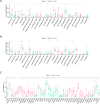A novel immune checkpoint score system for prognostic evaluation in pancreatic adenocarcinoma
- PMID: 37024802
- PMCID: PMC10080823
- DOI: 10.1186/s12876-023-02748-w
A novel immune checkpoint score system for prognostic evaluation in pancreatic adenocarcinoma
Abstract
Background: Pancreatic adenocarcinoma (PAAD) remains a lethal malignancy making the detection of novel prognostic biomarkers urgent. Limited studies have investigated the predictive capability of immune checkpoints in PAAD.
Method: Gene expression data and correlative clinical information of PAAD cohort were obtained from public databases, including TCGA, ICGC, GTEX and GEO databases. Risk factors were screened and used to establish a risk score model through LASSO and Cox regression analyses. The prognostic ability of the risk score model was demonstrated. The association between risk score with immune cells infiltration, immune checkpoint genes expression, immunogenic cell death, somatic mutations and signaling pathways enrichment were analysed. scRNA-seq data were collected to confirmed the immune checkpoints expression in PAAD samples. The prognosis prediction ability of OX40/TNFRSF4 was identified. The mRNA and protein expression of OX40 in our clinical specimens were examined by RT-PCR and IHC method and its prognosis ability was verified.
Results: First of all, the difference of immune microenvironment between pancreatic cancer and adjacent tissues was shown. A risk score system based on three immune checkpoints (OX40, TNFSF14 and KIR3DL1) was established. The risk score model was an independent prognostic factor and performed well regarding overall survival (OS) predictions among PAAD patients. A nomogram was established to facilitate the risk model application in clinical prognosis. Immune cells including naive B cells, CD8+ T cells and Tregs were negatively correlated with the risk score. The risk score was associated with expression of immune checkpoint genes, immunogenic cell death related genes and somatic mutations. Glycolysis processes, IL-2-STAT5, IL-6-STAT3, and mTORC1 signaling pathways were enriched in the high-risk score group. Furthermore, scRNA-seq data confirmed that TNFRSF4, TNFSF14 and KIR3DL1 were expressed on immune cells in PAAD samples. We then identified OX40 as an independent prognosis-related gene, and a higher OX40 expression was associated with increased survival rate and immune environment change. In 84 PAAD clinical specimens collected from our center, we confirmed that higher OX40 mRNA expression levels were related to a good prognosis. The protein expression of OX40 on tumor-infiltrating immune cells (TIICs), endothelial cells and tumor cells was verified in PAAD tissues by immunohistochemistry (IHC) method.
Conclusions: Overall, our findings strongly suggested that the three-immune checkpoints score system might be useful in the prognosis and design of personalized treatments for PAAD patients. Finally, we identified OX40 as an independent potential biomarker for PAAD prognosis prediction.
Keywords: Immune checkpoints; Immune risk score model; OX40; Pancreatic adenocarcinoma; Prognostic evaluation.
© 2023. The Author(s).
Conflict of interest statement
The authors declare no competing interests.
Figures











Similar articles
-
CD8 + T-Cell-Related Genes: Deciphering Their Role in the Pancreatic Adenocarcinoma TME and Their Effect on Prognosis.Dig Dis Sci. 2025 Jan;70(1):262-284. doi: 10.1007/s10620-024-08715-z. Epub 2024 Nov 27. Dig Dis Sci. 2025. PMID: 39604668
-
Development and Validation of an Inflammatory Response-Related Gene Signature for Predicting the Prognosis of Pancreatic Adenocarcinoma.Inflammation. 2022 Aug;45(4):1732-1751. doi: 10.1007/s10753-022-01657-6. Epub 2022 Mar 23. Inflammation. 2022. PMID: 35322324
-
Cuproptosis-related lncRNA scoring system to predict the clinical outcome and immune landscape in pancreatic adenocarcinoma.Sci Rep. 2023 Nov 27;13(1):20870. doi: 10.1038/s41598-023-47223-4. Sci Rep. 2023. PMID: 38012210 Free PMC article.
-
System analysis based on the pyroptosis-related genes identifies GSDMC as a novel therapy target for pancreatic adenocarcinoma.J Transl Med. 2022 Oct 5;20(1):455. doi: 10.1186/s12967-022-03632-z. J Transl Med. 2022. PMID: 36199146 Free PMC article.
-
Identify potential prognostic indicators and tumor-infiltrating immune cells in pancreatic adenocarcinoma.Biosci Rep. 2022 Feb 25;42(2):BSR20212523. doi: 10.1042/BSR20212523. Biosci Rep. 2022. PMID: 35083488 Free PMC article. Review.
Cited by
-
Multi-omics and AI-driven immune subtyping to optimize neoantigen-based vaccines for colorectal cancer.Sci Rep. 2025 Jun 2;15(1):19333. doi: 10.1038/s41598-025-01680-1. Sci Rep. 2025. PMID: 40456769 Free PMC article.
References
MeSH terms
Grants and funding
- 82072693, 81902417, 82172884/the National Natural Science Foundation of China
- 2019-01-07-00-07-E00057/the Scientific Innovation Project of Shanghai Education Committee
- SHDC12018109/Clinical and Scientific Innovation Project of Shanghai Hospital Development Center
- SHDC2020CR1006A/Clinical Research Plan of Shanghai Hospital Development Center
- 2020YFA0803202/National Key Research and Development Program of China
LinkOut - more resources
Full Text Sources
Medical
Research Materials
Miscellaneous

